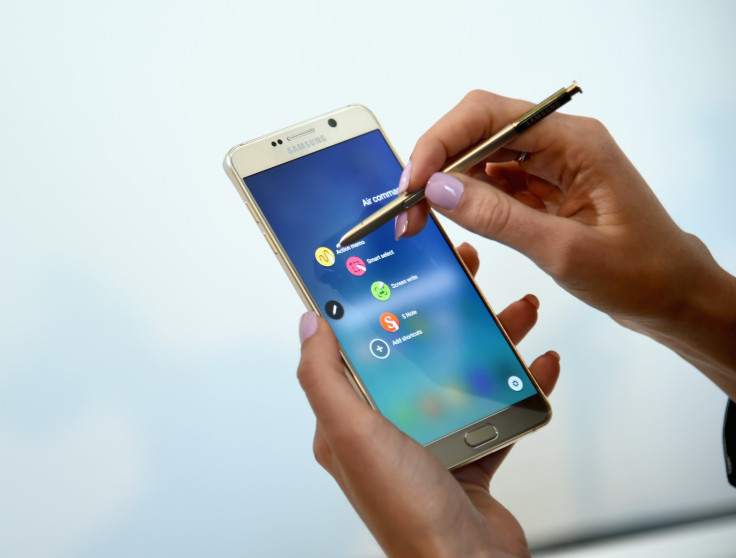Samsung, Desperate To Regain Market Share, Lures iPhone Customers With Galaxy S6 30-Day Test Drive

Samsung is trying a new tactic to lure away Apple’s customers. For $1, the South Korean handset manufacturer will give mobile shoppers a 30-day test drive of its Galaxy S6 Edge, S6 Edge Plus and Note 5 -- but only if they already own an iPhone.
It’s the latest attempt from an increasingly desperate Samsung to attract new users in the wake of poor sales of its latest Galaxy Android smartphones. At the end of July, Samsung announced its fifth consecutive quarter of declining profits -- largely due to the disappointing performance of its Galaxy S6 and S6 Edge. Both models failed to capture the hearts and wallets of consumers who were expecting bigger improvements over previous models -- the latest sign that Samsung, which ruled the smartphone market just a couple of years ago, is stagnating.
To take advantage of the offer, iPhone owners must visit the promotional website from their device, choose their current carrier and the Samsung model they want to try. After they fill out a form and enter credit card details, Samsung will send them a test model. Once the 30-day trial period is up, iPhone owners can either choose to purchase the Samsung device or return it.
But if it’s not returned within a five-day grace period after the end of the loan period, Samsung may charge the full price of the respective device, Samsung’s terms and conditions say. Water damage or a damaged screen will cost trial customers $100.
Samsung's attempt to siphon off iPhone users isn't unusual. Its ads for the S6 touted the benefits of wireless charging compared to carrying cables around and with the S5 it mocked iPhone users for being “wall-huggers” by needing to charge their phones throughout the day. While those ads tended to portray Apple’s iPhone in an adversarial position, Samsung’s test drive may be a sign of desperation.
'Competitive Frustration'
“[The promotion is] absolutely born out competitive frustration,” said Tim Bajarin, president of Creative Strategies. “It’s really an aggressive move to attract [Apple operating system] iOS users. But what Samsung doesn’t understand is this is not a hardware play. This is really about operating systems and ecosystems.” While it’s possible for Samsung to make phones that can be better than iPhones on the hardware front, it hasn’t been able to match the ecosystem of software and support with Apple’s products, he added.
For example, Apple supports its devices long after it has stopped selling them. Its next mobile operating system -- iOS 9 -- will support the nearly 4-year-old iPhone 4S when it's launched this fall. In comparison, Android updates can be slow to roll out, because they have to pass from Google to Samsung and then through individual carriers. Not to mention, Apple has its roster of Genius Bars customer service desks located in most of its Apple Stores for easy access to technical help. Samsung has only seven dedicated walk-in customer-service locations in the United States.
Samsung still holds the lead for overall handsets sold globally. But not necessarily profits. That title belongs to Apple, which recorded 92 percent of global smartphone profits in the first quarter of 2015, says Canaccord Genuity data cited by the Wall Street Journal. Samsung took 15 percent. [The combined total of both manufacturers’ profits is more than 100 percent of the industry’s profit since other manufacturers either broke even or lost money.]
Attacked From All Sides
Samsung is getting attacked from all sides. Despite a slowing smartphone market, Apple has continued to grow in China and around the world by dominating the premium high-end smartphone market in the second quarter, advisory firm Gartner says. Chinese manufacturers such as Xiaomi and Huawei also saw some marginal gains at the budget and mid-priced smartphone tier. But most of their gains came at the cost of Samsung, which saw its share fall to 21.9 percent, down 4.3 percent compared to the same quarter in the previous year.
It’s a far cry from just two years ago, when Samsung held 31.3 percent of the market with 316.4 million units shipped in 2013, driven by sales of its Galaxy S4 and its wide array of smartphones, IDC reported. While it saw shipment volumes increase marginally in 2014 to 318.2 million units, its market share shrunk to 24.5 percent, partially due to poor sales of the Galaxy S5 in 2014, the Wall Street Journal reported.
In the years after the S4, it didn't help that budget Android manufacturers were following Samsung by making larger screens. At the other end of the spectrum, Apple followed suit with the 4.7-inch iPhone 6 and 5.5-inch iPhone 6 Plus, which attracted "the highest Android switcher rate," Apple has ever measured, Apple CEO Tim Cook said during an investor call.
For now Samsung is placing its bets on its latest phablets -- the Galaxy Note 5 and the S6 Edge Plus, which went on sale Friday in the U.S.
© Copyright IBTimes 2025. All rights reserved.





















